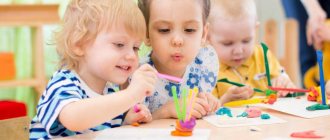As the child grows and develops, the scope of his capabilities constantly expands. Over time, he experiences a transition from primitive manipulations with objects to more conscious activities. Various types of leading activities in infancy can have a positive impact on the psychological development of the child and form him into a truly versatile and interesting person. Any changes that occur during this period of time have a strong impact on the formation of the baby and the process of developing his personality.
Characteristics
Pediatricians and psychologists have identified the main distinctive features of the leading activities of a child in infancy:
- help the baby develop a number of new actions that he will fully master in the future;
- with their help, the emergence and restructuring of certain functions of the psyche of a growing baby occurs;
- influence the personality and make visible changes in it.
The mental development of a child depends on the appropriate type of leading activity. When changing activities, one can clearly say that the child has moved to another, more advanced stage of his development.
Definition and features of the concept
Leading activity is the type of activity of the child that, at a certain stage of his growing up, has a key influence on him. Each stage has its own options for activities and all parents are required to clearly know them. Note that this is not one specific type of action, but a complex of them. Mastery of each of these actions helps the child seamlessly move to the next stage of development. For all children, the age from birth to approximately six to seven years is particularly critical in terms of their emotional, psychological and physical development, as well as the process of their socialization.
It is important that the child’s leading activity in each of the periods, which we will talk about a little further, corresponds to his mental and psycho-emotional capabilities
Structure and main varieties
The process of human mental development in the period from infancy to preschool age is classified into three separate structures:
- persisting – moved from the previous stage;
- direct – determines the current stage of leading activity;
- nascent is a stage that is only at the initial stage of its development and will be the main one at the next stage.
Experts include the following among the leading types of activity in infancy and in subsequent periods:
- direct communication of the child with adults and people around him through emotions (age range from birth to one year);
- object-manipulative (from one to three years);
- play (from three years to the start of school).
For schoolchildren aged 6 to 11 years, the priority is the educational process, and for adolescents aged 11 to 15 years, communication with peers is the priority. The most important period of development for a child is the period from 0 to 7 years.
Early age
Yaroslavtseva Svetlana
Early age
Introduction
The position on the importance of the social environment and the child’s communication with adults and peers for mental development and personality formation is generally recognized in modern psychology. However, the question of the mechanisms of influence of the social environment on human development is interpreted differently depending on the theoretical model of development adopted in various schools and directions - behavioral psychology, social learning theory, epigenetic approach, model of ecological systems, psychology of operational development of intelligence, cultural-historical approach. In the doctrine of the structure and dynamics of psychological by L. S. Vygotsky introduced the concept of the social situation of development as the most important characteristic of age , revealing the relationship between the child and his social environment. The age specificity and content of the category social situation of development at stable and crisis ages were subjected to in-depth theoretical and experimental analysis in the works of domestic psychologists (L. I. Bozhovich, V. V. Davydov, M. I. Lisina, D. B. Elkonin, D. I. Feldshtein, etc.). It was shown that the features of the social situation of development decisively determine the direction, content and nature of the child’s development in the normative space of age-related development . At the same time, in modern child psychology there is an increasingly acute awareness of the need to specify the concept of “social situation of child development”
both theoretically and to solve urgent and important problems of optimization, prevention and correction of children’s mental development.
Early age covers the period from 1 to 3 years and is one of the key ones in a child’s life. It is characterized by a new social situation of development, since at this stage of his life the leading subject becomes ethno-manipulative activity, which replaces emotional communication with an adult (the leading activity of the infant; important new formations arise.
Social situation of development in early childhood .
The special significance of early childhood lies in the fact that it is directly related to walking. The ability to move, while a physical asset, has tangible mental consequences. Thanks to her, he begins to walk freely and communicate more independently with the outside world. Walking develops the ability to navigate in space, expands the ability to become familiar with the environment, and also provides a transition to independent objective activity. The baby is completely absorbed in objects, as a result of which his relationships with adults change. Emotional communication with them is becoming less and less common, giving way to situationally effective communication, practical cooperation, and joint actions with objects. An adult, as a rule, is disposed to communicate due to his business qualities, and not his emotionality. The social situation of development in early childhood has the following structure: “child - object - adult”.
Leading activities in early childhood .
For early childhood, the main activities are object activity, speech and play. The development of objective activity is associated with the mastery of methods of using objects developed by mankind. A child learns from adults how to use objects and understands the meaning of things. The difference between object-based activity and the simple manipulation of objects characteristic of the infant period lies in the subordination of the child’s methods of action with objects to their functional purpose in the life of a cultured person.
The means of carrying out objective activity, the instrument of mastering social ways of using objects, is communication. Despite the fact that emotional communication ceases to be a leading activity in early childhood , it continues to develop very intensively and becomes verbal. After all, communication connected with objective actions cannot only be emotional; it must be mediated by words.
Early age is sensitive (favorable)
period for speech development since it is at this time that language acquisition is effective.
By the age of three, the child masters speech breathing, all the sounds of his native language are given, his vocabulary is 1200-1500 words, he does not use common sentences (5-6 words, which indicates the mastery of the basics of syntax, he is active in verbal communication with adults and children, masters expressive and facial actions (smile, eye contact, movements, postures, touches, etc.)
If a child for some reason does not have the necessary conditions for speech development, then it is very difficult to catch up later. In the first year of life, it is necessary to especially and intensively engage in speech development.
For the development of a child, play is of particular importance - an activity aimed at orientation in objective and social reality.
Elements of the game are already used by infants, manipulating objects (toys, pacifiers)
.
In the second year of life, play becomes more spontaneous and meaningful. It is not just manipulation, but unfolds as an action with objects in which the child reproduces what adults do (for example, talking on the phone, drinking tea)
.
These are the first steps on the path to symbolic actions, common types of games at this age are pre-exploration play (playful exploration of the features of objects, construction play (independent construction of structures and playing with them, role-playing play ( child taking on the role of an adult)
game.
There are different views among researchers regarding the causes and purposes of play. Supporters of psychoanalytic theory, for example, believe that role-playing play helps a child cope with conflicts. However, being reflected in the game, psychological conflicts are not always its cause. If, while playing with a doll, a child cares deeply about it, it is quite possible that this expresses her need for love and compensates for the lack of parental warmth.
The child’s play activity is the basis for the formation of future skills and mental actions. In the process of gaming experimentation, many new complex abilities are formed. Up to two years old, children can already play elementary logic games (involve the use and development of logical thinking skills)
and thematic
(assigned by adults or independently
chosen ) games, demonstrating their ability to draw up an action plan.
With the development of symbolic (conventional designation in the game of objects, events, phenomena)
games change the child’s attitude towards other children. In the first year of life, they hardly interact with each other; children treat each other like living toys: they pull their hair, touch their eyes with their fingers, etc. At 18-20 months, they begin to interact with play partners and strive to play with each other. with a friend.
So, objective activity, speech and play indicate the mental development of the baby. These types of activities reveal certain mental neoplasms of early childhood .
Characteristics of full communication young child and adults :
— initiative towards the elder, the desire to attract his attention to his actions;
- preference for substantive cooperation with an adult, insistent demand from an adult for complicity in their affairs;
- gullibility, openness and emotionality in relation to an adult, showing love for him and a willing response to affection;
- sensitivity to the attitude of an adult, to his assessment and restructuring of one’s behavior depending on the behavior of an adult, a subtle distinction between praise and blame;
- active use of speech in interaction.
The social situation of development is “a completely unique, specific for a given age , exclusive, unique and inimitable relationship between the child and the reality around him, primarily social.”
An age crisis is a special period of transformation of the social situation of development: a new formation of the previous period destroys the old development situation and provokes the formation of a new one. According to Vygotsky, the age crisis is the norm of ontogenesis.
The concept of a social situation of development was introduced by L. S. Vygotsky as a unit of analysis of the dynamics of a child’s development, that is, a set of laws that determine the emergence and changes in the structure of a child’s personality at each age stage . The social situation of development determines the child’s lifestyle, his “social being”
, during which they manifest new personality traits and develop new mental formations.
Being a product of age-related development , neoplasms appear towards the end of the age period and lead to a restructuring of the entire structure of the child’s consciousness, to changes in the system of his relationships to the world, other people, and himself. The appearance of new formations is a special sign of the collapse of the old social situation of development and the formation of a new social situation of development, which is accompanied by crises of age-related development . The concept of social situation of development was defined by B. G. Ananyev and, in his opinion, it is aimed at overcoming ideas about the environment as a factor that mechanically determines the development of the individual. Subsequently, this concept received a detailed analysis in a macro-social-psychological context and was used to describe, for example, the ontogenetic development of a child’s personality by L. I. Bozhovich, D. B. Elkonin, who defined age characterized by the following main indicators:
1) a certain social situation of development - the specific form of relationships that a child enters into with adults in a given period;
2) main or leading type of activity;
3) the main mental new formations acquired at this stage of development (from individual mental processes to personality traits)
. And also as a relatively closed period, the significance of which is determined primarily by its place on the general curve of child development.
Thus, the social situation of development is specific for each age period , determined by the system of relations of the subject in social reality, reflected in his experiences and realized by him in joint activities with other people.
Object of study: children from infancy to adolescence .
Social situation of infant development.
This situation is determined by the complete helplessness of the baby and the absence of any means of independent existence and satisfaction of its needs. The only such “means”
there is another person - an adult who mediates absolutely all the manifestations of the baby. Whatever happens to the baby, he is always in a situation related to the adult caring for him. Objects appear and disappear from the child’s field of vision always thanks to the participation of other people; the child always moves in space on someone else’s legs and arms; the elimination of irritants that interfere with the baby and the satisfaction of his basic needs is always accomplished through other people.
he designates the main neoplasm of infancy with “couple - we”
, and implies by it the original mental community of mother and child.
Harmony and synchronicity of interaction between mother and child are the most important fact of the psychology of infancy. This fact suggests that not only the child “adapts”
to the mother, but she also adapts to the child’s actions. The child and mother mutually change and develop each other. It is in this ability for harmonious interaction and in the general disposition to communicate with adults that the baby’s activity is manifested.
Social situation of development at an early age .
At the end of the first year of life, the situation of unity between the child and the adult explodes from the inside. Two opposite but interconnected poles appear in it - a child and an adult. By the beginning of early childhood, the child , acquiring the desire for independence and independence from the adult, remains connected with the adult and objectively (since he needs the practical help of an adult)
and subjective
(since it needs an adult’s assessment, his attention and attitude)
. This contradiction finds its resolution in the new social situation of the child’s development, which represents cooperation, or joint activity of the child and the adult.
Communication between a child and an adult begins to be mediated by objects already in the second half of infancy. However, the child isolates only individual objects and considers the adult himself as an interesting object. In the second year of life, the content of the child’s substantive cooperation with an adult changes radically. The content of their joint activity is the assimilation of socially developed ways of using objects. The uniqueness of the new social situation of development, according to D. B. Elkonin, lies in the fact that now the child does not live with an adult, but through an adult, with his help. The adult does not do it instead of him, but together with him.
The content of communication becomes extra-situational, going beyond the perceived situation.
M.I. Lisina identified two non-situational forms of communication characteristic of preschool age - cognitive and personal.
In the first half of preschool age (3 - 5 years)
An extra-situational-cognitive form of communication between a child and an adult appears.
Unlike the previous one (situational business),
it is woven not into practical cooperation with an adult, but into
“theoretical” (why this is so)
.
Since it is not the situation that is being discussed, communication for the first time acquires an extra-situational character.
By the end of preschool age, a new and highest for preschool age - an extra-situational-personal form of communication. Unlike the previous one, its content is the world of people, not things. A preschooler is interested in a variety of aspects of an adult’s existence that are not visible in a specific situation and do not concern the child himself (where he lives, who he works for, whether he has children, etc.)
.
He talks just as willingly about himself (about his parents, friends, joys and grievances)
.
The need for mutual understanding and empathy of an adult is the main one for extra-situational-personal communication.
The contradiction in the social situation of a preschool child’s development lies precisely in the gap between his desire to be like an adult and the impossibility of realizing this desire directly. The only activity that allows you to resolve this contradiction is a role-playing game. In such a game, the child takes on the role of an adult as a bearer of social functions and enters into a certain relationship with other “ideal adults”
.
That is why role-playing game gives the child the opportunity to interact with aspects of life that are inaccessible to him in real practice, and it is the leading activity of a preschooler.
Regardless of the age period of the child’s development, the social situation is decisive and conditions the process of the child’s life, during which he manifests new personality traits and develops new mental formations, which in turn leads to a restructuring of the entire structure of the child’s consciousness, to changes in the system of his relations to the world, to other people, to yourself.
The social situation, being a unit, allows us to most accurately track the emergence and changes in the structure of the child’s personality at each age stage .
Thus, the social situation of development is a system of relations of the subject in social reality, realized by him in joint activities with other people.
New formations are achievements in development, characterized by a special type of personality structure and activity, as well as the child’s attitude towards himself and other people.
The most important neoplasm of the newborn period is the revitalization complex. The revitalization complex is an emotionally positive reaction that is accompanied by movements and sounds. Before this, the child’s movements were chaotic and uncoordinated. The complex develops coordination of movements. The revival complex is the first act of behavior, the act of distinguishing an adult. This is also the first act of communication. The revitalization complex is not just a reaction, it is an attempt to influence an adult (works by N. M. Shchelovanova, M. I. Lisina, S. Yu. Meshcheryakova)
.
The revitalization complex is the main neoplasm of the critical period. It marks the end of the newborn and the beginning of a new stage of development - the stage of infancy. Therefore, the appearance of the revival complex represents a psychological criterion for the end of the neonatal crisis.
Infancy and the 1st year crisis. By 9 months—the beginning of the 1st year crisis—the child stands on his feet and begins to walk. As D. B. Elkonin emphasized, the main thing in the act of walking is not only that the child’s space expands, but also that the child separates himself from the adult. For the first time, the unified social situation “We” is fragmented; now it is not the mother who leads the child, but the child who leads the mother wherever he wants. Walking is the first major new development of infancy , marking a break in the old developmental situation.
The second main new development of this age is the appearance of the first word. The peculiarity of the first words is that they are in the nature of pointing gestures. Walking and enriching object actions require speech that would satisfy communication about objects. Speech, like all neoplasms of age , is transitional in nature. It is autonomous, situational, emotionally charged and understandable only to those close to you. This speech is specific in its structure, consisting of fragments of words. Researchers call it "nanny language." But whatever this speech may be, it represents a new quality that can serve as a criterion that the old social situation of the child’s development has disintegrated. Where there was unity, there are two: an adult and a child. Between them a new content grew - objective activity.
Basic psychological neoplasms of early age . All major neoplasms are associated with the development of tool-object activity leading at an early age . Within this activity, mental processes develop - perception, memory, thinking, speech. In this activity, a new type is born, which will become the leader in the next psychological age . This is a plot-based game.
Comparing one’s actions with the actions of an adult (an image and a model, finding similarities between them is a necessary condition for the emergence of a tendency towards independence. When a single objective action disintegrates and the adult is separated from the child, the child for the first time sees the adult and his actions as models, it turns out that the child acts as an adult, not with him, not under the guidance of an adult, but as he does. As soon as the child saw himself in another, he saw himself and the phenomenon “I myself” appeared. L. S. Vygotsky called it new formation "external I myself." The tendency to independent actions is associated with the emergence of personal action. Personal action is an action that the child treats as if it was carried out by himself. The performance of such an action is accompanied by the appearance of the pronoun "I" in speech. Until this time, the child spoke about himself in the third person or called himself by name.
The beginning of personality is a long and multiphase process of early socialization of an individual, which occurs most intensively at two or three years of age .
B. G. Ananyev notes that the social formation of a person is not limited to the formation of personality. This is also the formation of a person as a subject of cognition and activity.
Conclusion.
L. S. Vygotsky defined the social situation of development as a special social space that an adult creates for the development of a child’s personality. It is determined by the system of social conditions that an adult organizes when interacting with a child. At the same time, the social situation of development turns out to be relatively stable during a specific age stage : the adult strives to preserve the conditions in which the child develops. But since the child himself changes, acquiring new qualities, his attitude to the social situation of development and to the process of interaction with adults changes - from acceptance to complete denial.
A. N. Leontyev, defining the social situation of development, proposed to characterize the basic relationship between the child and his environment through activity. According to A. N. Leontyev, there is a leading activity, that is, an activity that has a decisive influence on the development of the psyche in a specific age period . In infancy , the leading activity is the child’s communication with an adult, at an early age - objective activity, in preschool - play, in primary school - educational activity.
Activities from 0 to 1 year
At the beginning of life, the baby is completely dependent on the mother or the person who replaces her. Therefore, it is impossible to determine the leading activity of infants in the period from 0 to 2 months.
With the beginning of the second period (age from two months to a year), the main process for the child becomes close emotional communication with a person close to him - his mother. It is this that helps create important processes in the baby’s mental system:
- the ability to share sensations and emotional states at a conscious level;
- involuntary attention (the child gets the opportunity to independently fix his attention on specific objects around him for a short period of time);
- the rudiments of visual and effective thinking begin to emerge in his mind;
- perception of surrounding objects;
- the appearance of autonomous speech.
Leading activity in infancy helps to form a central, basic new formation, which determines the transition to the next, more advanced stage of development of the little person. In the future, the need to communicate with people around you will become more and more acute.
In infancy, what activities lead
Expect
call me back
Your personal manager: Ekaterina Responsible and responsive!









